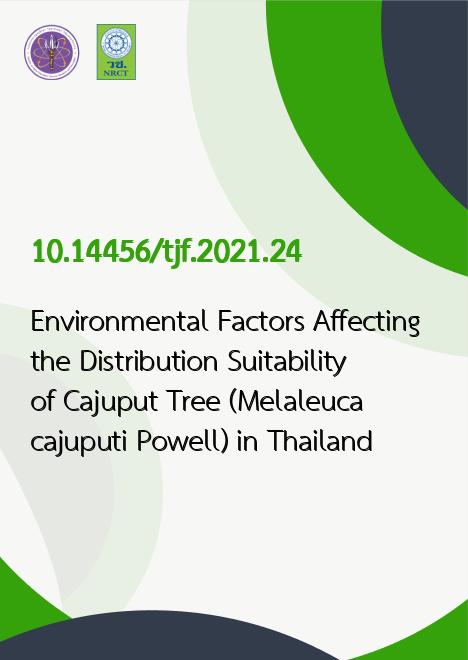
|
Environmental Factors Affecting the Distribution Suitability of Cajuput Tree (Melaleuca cajuputi Powell) in Thailand |
|---|---|
| รหัสดีโอไอ | |
| Creator | Janthima Yoothaworn |
| Title | Environmental Factors Affecting the Distribution Suitability of Cajuput Tree (Melaleuca cajuputi Powell) in Thailand |
| Contributor | Yongyut Trisurat, Wattanachai Tasen, Auschada Chitechote |
| Publisher | Kasetsart University |
| Publication Year | 2564 |
| Journal Title | Thai Journal of Forestry |
| Journal Vol. | 40 |
| Journal No. | 2 |
| Page no. | 155-171 |
| Keyword | Environmental factors, Melaleuca cajuputi Powell, Species distribution modelling, MaxEnt |
| URL Website | https://li01.tci-thaijo.org/index.php/tjf/article/view/251725 |
| Website title | Thai Journal of Forestry |
| ISSN | 2730-2180 |
| Abstract | We aimed to study the environmental factors affecting the suitability distribution of Cajuput tree (Melaleuca cajuputi Powell) in Thailand and to determine the relationship between ecological factors and or occurrence of Cajuput tree. Suitable areas for its distribution across Thailand were assessed using plant specimens at the Forest Herbarium-BKF, Department of National Parks, Wildlife and Plant Conservation and the Botanical Garden Organization. These included the occurrence data from BIEN (Botanical Information and Ecology Network). A predicted distribution map was constructed using the Maximum Entropy (MaxEnt) method. The research indicated that 5 related ecological factors were important to determine the occurrence of Cajuput tree. These included the mean sea level (41.5%), the distance from the sea (15.8%), relative humidity (15.1%), soil group (5%), and the rainfall (4.8%). The areas suitable for the distribution of Cajuput tree were determined based on an AUC value of 0.98 indicating high reliability, while the accuracy of prediction was 84%. The distribution of total suitability area of the tree was 13,451 square kilometers, located in 24 provinces (2.64% of the country area). The area on the South Eastern coast covered 9,012 square kilometers (67% of the suitable distribution area), followed by the Eastern region (2,360 square kilometers or 17.55%), Southern Western coast (1,984 square kilometers or 14.75%), and other areas estimated at around 95 square kilometers. The most suitable area for the distribution of Cajuput tree is located in Nakhon Si Thammarat province, with a total area of 2,206 square kilometers, with the conservation status of the Cajuput tree as a vulnerable species as determined by the extent of occurrence (EOO) of less than 20,000 square kilometers. |